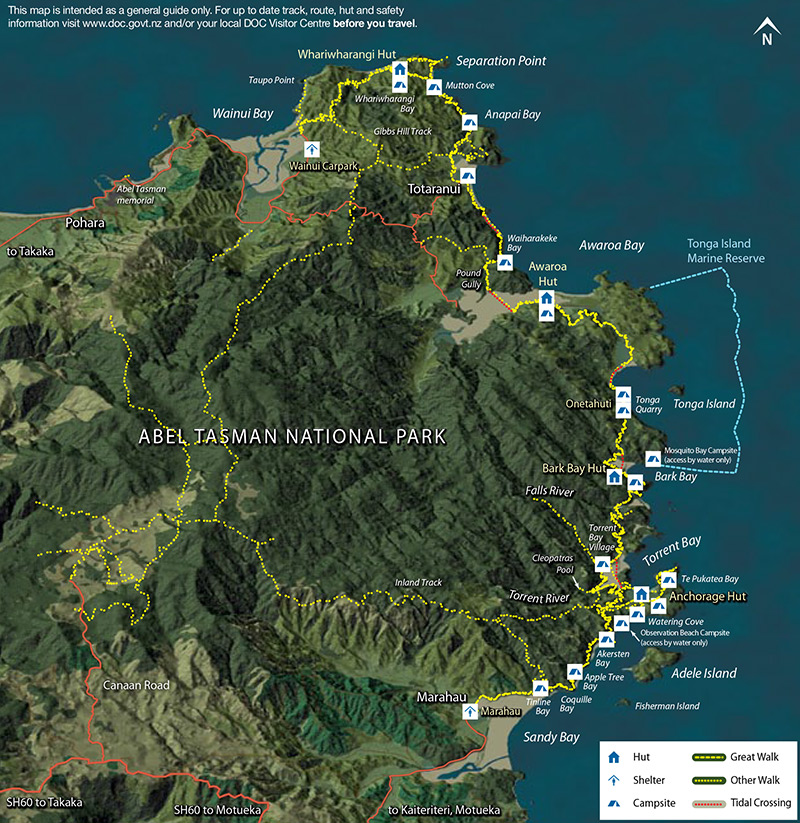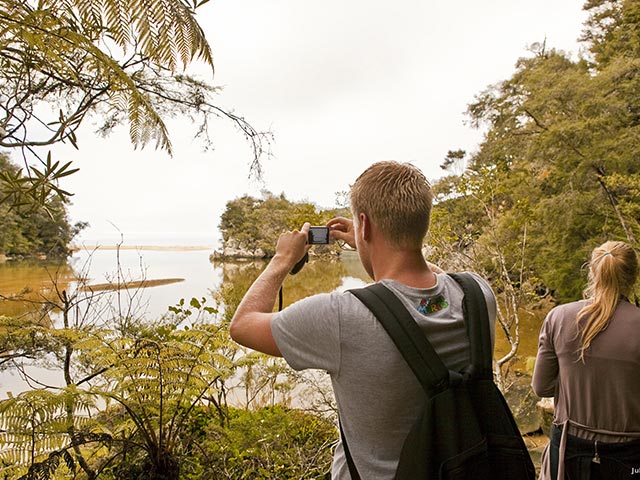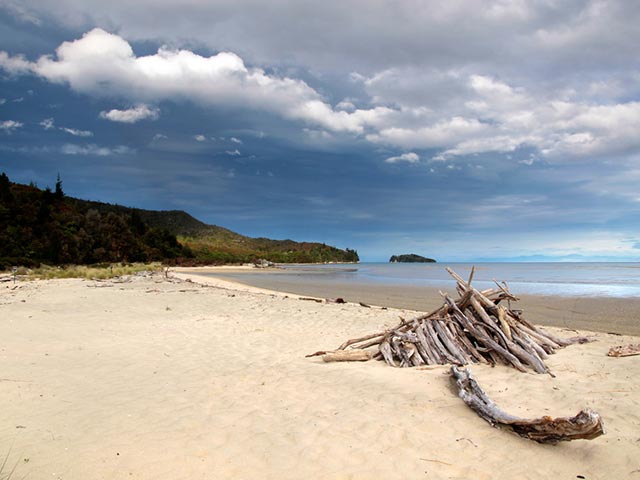Abel Tasman Experience
The Abel Tasman Experience in the North West of New Zealand’s South Island begins in Abel Tasman National Park
Duration: 3 days
This exhilarating outdoor package sea kayaking and tramping part of the Abel Tasman Coast Track, brings visitors past golden beaches, coastal forests and towering cliffs. Established in 1942 by ornithologist and author Perrine Moncrief, it was named after the Dutch explorer credited with being the first European to see the country’s shores. With a size of 225.3 sq km it is New Zealand’s smallest national park bordering Golden and Tasman Bay. The crystal clear water and marine reserves is a feature of this diverse and naturally beautiful area. Starting and finishing at Marahau, the Abel Tasman Experience takes 3 days to complete. Please Note: due to safety reasons, there is a 2 hikers minimum to do this walk, unable to book the Abel Tasman Experience as a solo traveller.
What’s included:
- Package includes 5 days and 4 nights
- Pre and Post Accommodation in a 3 star motel or equivalent in Nelson (twin share)
- Transportation ex Nelson to and from the walk
- 3 Day Kayak Hire & Equipment
- Walk with 2 nights in Department of Conservation Huts
From NZ$ 525 per person (2 person minimum)
Numbers are limited – Book early to secure your space.
2020/2021 Season is Open
Please note the walk is fully booked over the following dates:
- 07 Nov 2020 – 19 Feb 2021
- 27 Feb – 05 Mar 2021
- 01-05, 17-25 Apr 2021
Independent Kayak/Walking Guide

Day 1
Kayak Marahau to Anchorage Hut
Paddling 3 – 4 hours / Walk 1.2 hours
Prior to your start from Marahau you will receive a full briefing on safety and weather, an updated forecast and map orientation. Once you are made familiar with your equipment and kayak, your journey over the aqua coloured waters of Tasman National Park coast begins as you make your way to Anchorage Hut. Depending on your pace and mood, feel free to explore the islands, observe the wildlife and lush vegetation as wander golden sandy beaches on your way to your first stopover.
Once settled at the Anchorage campsite an option to stretch the legs after paddling is taking a loop track to Te Pukatea Bay and onto the old pa site at Pitt Head. The 1hour and 20 minute walk gives commanding views of the Abel Tasman coast.
Day 2
Anchorage Hut to Onetahuti / Onetahuti to Awaroa Hut
Paddling 3 – 4 hours / Walk 2 hours
This morning paddle your way from Anchorage to Onetahuti. Kayak through the middle of the Tonga Island Marine Reserve. Tonga Island has one of the largest seal populations in the park so keep an eye out for seals that share the coastal waters. On arrival at Onetahuti you will need to leave your kayaks here before continuing on the next part of your journey. Cross the tidal stream and follow the track that climbs through bush over Tonga Saddle and then decends to Awarao Inlet, following the shoreline to Awaroa Hut. Note: The stream can be only be crossed within 3 hours either side of low tide.
Day 3
Awaroa Hut to Totaranui Campsite
Depending on tide times there are two alternative outcomes for the Abel Tasman Experience
Morning tide
You have the option of walking to Totaranui (5.5km / 1.5 hours walking).
With a morning low tide, you must cross the Awaroa Inlet 1-1/2 hours before or up to two hours after low tide. Once across, you head across a saddle before going down to Waiharakeke Bay and the native forest beyond. Enjoy a meander through the native growth and birdlife before re-emerging onto the coast at Goat Bay. An ascent then brings to s tunning outlook above Skinners Point before the days final descent to Totatanui Campsite and a water taxi back to Marahau.
Afternoon tide
Otherwise if you are there for an afternoon tide you can stay at the Awaroa Hut and get picked up by water taxi from there.
Please note: Great Walks staff will discuss your options in detail as well provide you with a full itinerary and tide times following confirmation of your package.
Please note: Great Walks staff will discuss your options in detail as well provide you with a full itinerary and tide times following confirmation of your package.
More Details On The Trip
What should I bring?
To enjoy freedom walking a spare set of the clothes and underwear you are most comfortable wearing will ensure the hours on the track are a pleasure not a chore. Drying garments in the hut is often not possible for safety reasons so polypropylene and light wool with its fast drying qualities and ability to keep you warm even when it is wet is the most recommended material. Cotton clothing such as jeans, T-shirts and sweatshirts can be a serious liability when wet and have been responsible for a number of hypothermic incidents for hikers caught out in the cold.
Temperatures can vary during the day, with rain, sun and snow possible all on the same day at any time of the year. To ensure your clothing and sleeping bag stays dry we recommend you line your pack with a strong plastic bag before packing your gear into it.
Suggested clothing for the kayaks
-
-
- Swimsuit and towel
- Sunhat and sunglasses
- T-shirts and shorts
- Warm top (wool/fleece)
- Sandals
-
Suggested clothing for the walks
-
-
- 2 – 3 sets of fast drying clothing. One set to walk in and one set to change into at night. Layers of clothing are recommended to manage changing temperatures. It is not possible to dry clothing at the huts.
- Good quality walking / tramping boots
- Warm hat and gloves
- Swimming costume and towel (optional)
- Good quality warm wind and rain proof jacket (gortex or similar)
- Light weight shoes for around the hut
-
Personal equipment
-
-
- Earplugs (optional), but you will be sharing the huts with other people
- Pack with large waterproof / pack liner
- Water bottle — There is limited access to water on some places on the track
- Sleeping bag and sleeping bag liner
- Suncream
- Camera (optional)
- Torch and spare batteries — There is no lighting at the huts either in the living area or bunk rooms or between huts and ablution blocks.
- Plastic bags for wet gear
- Rubbish bag – You must remove all your rubbish from the track
- Toilet gear — Toothbrush, toothpaste, toilet paper, small towel, soap
- First aid kit — Insect repellent, plasters for blisters, personal medication (e.g. antihistamine for allergy to wasp stings)
-
Cooking
-
-
- Cooking utensils — Pot/pan/billy, matches or lighter
- Eating utensils — Knife, fork, spoon, plate, cup
- Small gas cooker, these are not supplied in huts on the Abel Tasman Track
- Pot scrubber, tea towel
-
Food
Food must be carried as it cannot be bought on the way, although some bartering may be possible especially if you have extra chocolate, gourmet cheeses or wine.
Breakfast cereals, crackers, cheese and jam for lunch and instant soup/dried pasta or dehydrated meals for dinner, snacks such as biscuits, muesli bars and tea and coffee will ensure you keep up energy levels without losing your appetite. Supermarkets in Nelson and Motueka will be able to supply all your food requirements. There are also a number of speciality outdoor stores which have a range of dehydrated meals and other food products specifically designed for multi-day walking.
Facilities at your accommodation
-
-
- Living areas in huts have gas cookers, cooking benches, tables, a filtered cold water and heating
- Bunkrooms are communal with a combination of platform and/or individual bunks with mattresses
- Ablution blocks have flush or vaulted toilets and washbasins with cold water only. Sorry no showers
- A Department of Conservation rangers are present on the track but not at each hut
-
Explore More Today
The Abel Tasman coastal environment is typically dry and warm in Summer, but it can change quickly exposing you to windy, cold conditions. Walkers are responsible for your own and party members safety. The Department of conservation have a new online Intentions System which replaces the intentions books at each hut. It is crucial for walkers to advise others of their intentions regarding dates and routes taken before they set off. Emergency locator beacons are also readily available for rent from Department of Conservation offices.
Take a moment to watch the short video and explore the maps and get a feel for how spectacular the Abel Tasman Coastal area is.


 Abel Tasman National Park
Abel Tasman National Park Abel Tasman Coast Experience
Abel Tasman Coast Experience